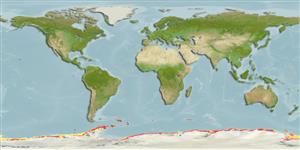Teleostei (teleosts) >
Perciformes/Notothenioidei (Icefishes) >
Nototheniidae (Cod icefishes) > Trematominae
Etymology: Trematomus: Greek, trematos = hole + Greek, tomo = section, cut (Ref. 45335); hansoni: Species name hansoni honors Nicolai Hanson, biologist of the Southern Cross Expedition..
More on author: Boulenger.
Issue
The genus Pseudotrematomus is a synonym of Trematomus, which is confirmed by a molecular study to be published (J.-C. Hureau, pers. comm. 08 Jun. 2010).
Environment: milieu / climate zone / depth range / distribution range
Ecology
Marine; demersal; depth range 6 - 549 m (Ref. 11892). Polar; 53°S - 78°S
Southern Ocean: South Orkneys, South Georgia and South Shetland islands. Ross, Davis and Weddell seas, South Victoria, Adelie, Queen Mary and Princess Ragnhild Coasts.
Size / Weight / Age
Maturity: Lm ? range ? - ? cm
Max length : 45.5 cm TL male/unsexed; (Ref. 58849); common length : 25.0 cm TL male/unsexed; (Ref. 2121)
Adults feed on small fishes, krill and other euphausiids, polychaetes, copepods, amphipods, isopods and small gastropods. Mature individuals spawn once a year (Ref. 1071).
Dewitt, H.H., P.C. Heemstra and O. Gon, 1990. Nototheniidae. p. 279-331. In O. Gon and P.C. Heemstra (eds.) Fishes of the Southern Ocean. J.L.B. Smith Institute of Ichthyology, Grahamstown, South Africa. (Ref. 5179)
IUCN Red List Status (Ref. 130435)
Threat to humans
Harmless
Human uses
Fisheries: commercial
Tools
Special reports
Download XML
Internet sources
Estimates based on models
Preferred temperature (Ref.
123201): -1.8 - 0.5, mean -1.1 °C (based on 348 cells).
Phylogenetic diversity index (Ref.
82804): PD
50 = 0.5005 [Uniqueness, from 0.5 = low to 2.0 = high].
Bayesian length-weight: a=0.00427 (0.00275 - 0.00661), b=3.29 (3.16 - 3.42), in cm total length, based on LWR estimates for this species & Genus-body shape (Ref.
93245).
Trophic level (Ref.
69278): 3.4 ±0.54 se; based on food items.
Resilience (Ref.
120179): Medium, minimum population doubling time 1.4 - 4.4 years (K=0.22-0.23; Fec = 5,851-12,000).
Fishing Vulnerability (Ref.
59153): High vulnerability (55 of 100).
Climate Vulnerability (Ref.
125649): High vulnerability (57 of 100).
Nutrients (Ref.
124155): Calcium = 22.8 [13.3, 57.4] mg/100g; Iron = 0.459 [0.186, 0.931] mg/100g; Protein = 17.1 [16.1, 18.2] %; Omega3 = 0.352 [0.194, 0.626] g/100g; Selenium = 15.5 [6.3, 37.8] μg/100g; VitaminA = 23 [5, 116] μg/100g; Zinc = 0.487 [0.313, 0.759] mg/100g (wet weight); based on
nutrient studies.
